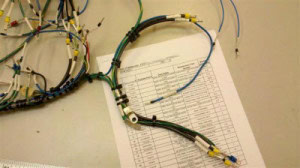
Towards the end of the 20th century, most wire harnessing processes, including insertion of wires into the connectors and bundling of wires, were done manually. Due to the lack of wire harness assembly automation, the manufacturing process took longer than other cable assemblies. Depending on the complexity of the wire harness, production time spanned from a few days to several weeks.
Although, complete automation cannot be done for insertion of terminated wires into connector housings, fully automated equipment and procedures are now available for cutting, stripping, and crimping of wire.
Complete Automation of Wire Harness Assembly
Recently, a system has been introduced that can automatically produce a complete custom wire harness from start to finish. It comprises a set of flexible machines, which can also take care of the insertion of terminated wires into assembly connectors.
This system can automatically cut, strip, and crimp wires of different gauges. It is equipped with sensors on the presses for quality control. Also, it can be fitted with a combination of stations, such as crimping presses and seal assembly stations.
Besides this, there are other innovations that can be used to simplify the wire insertion process. There are systems that use vision-guided lasers to command assemblers where to insert the wires. Also, certain procedures use computer-guided wire assembly and test systems to perform wire insertion. Such innovations have only further strengthened the efforts of automating cable assembly processes.
Beneficial Applications of Automating Cable Assembly Processes
Cable assembly automation can be helpful in various ways. Following are the major beneficial applications of automating cable assembly and wire harnessing processes:
- Fitting of terminals onto wires
- Soldering or tinning of the wire ends
- Plugging of wires into connector housings
- Testing a wire harness for electrical functionality
- Crimping terminals on one or both sides or the wires
- Specialized cutting machines for cutting and stripping the ends of individual wires
Considering the potential benefits and the solutions being introduced to solve this problem, it is safe to say that the future of wire harness assembly automation looks bright.
